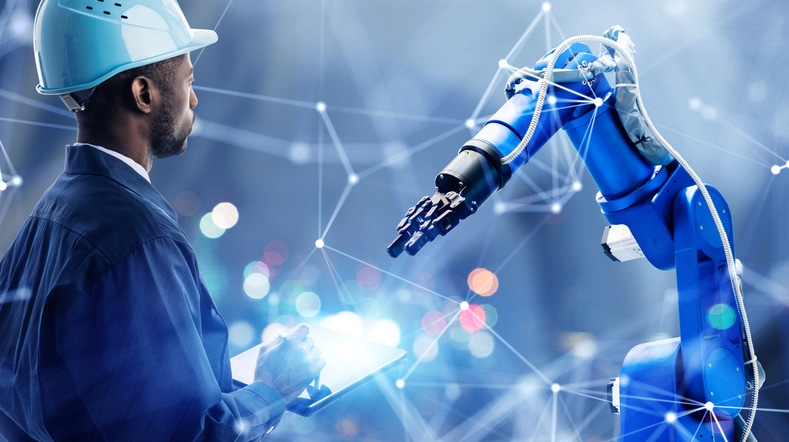Digital manufacturing technologies have surged in importance in 2020, but staffing challenges complicate deploying them.
August 4, 2020

The competitive landscape in the manufacturing sector has changed dramatically in 2020. The commercial aerospace and automotive industries, for instance, have struggled with steep demand declines. But some manufacturers such as ventilator and disinfectant manufacturers, have seen business surge.
Against that backdrop is the theme of digital transformation, which has transitioned from eventual necessity to immediate need for many manufacturers. Digital manufacturing technologies, including industrial Internet of Things (IIoT), promise to boost efficiency and agility while protecting workers.
An Increased Digital Focus in Manufacturing
“There’s a push for manufacturers to increase their digital footprint,” said Chander Damodaran, chief architect, digital at the consultancy firm Brillio. Damodaran reported there has been a pronounced shift from manufacturing-related pilot projects to broad-scale IIoT deployments in 2020.
The disruption the manufacturing sector has faced in the wake of the COVID-19 crisis has made “IoT a focal point” for new investments as well as a technological underpinning for new processes and systems, said Somit Kapoor, vice president and global head of Wipro’s Enterprise Operations Transformation unit.
Manufacturers and other organizations have turned to the Internet of Things to monitor “occupancy, building density, indoor air quality,” said Grant Erickson, president of Thread Group and principal software engineer at Google. “Those types of things are actually quickly starting to climb up quite a bit.”
[IoT World, North America’s largest IoT event, is going virtual August 11–13 with a three-day virtual experience putting IoT, AI, 5G and edge into action across industry verticals. Register today.]
While the manufacturing sector’s embrace of digitization is not new, the COVID-19 crisis has accelerated the trend while highlighting the risks for organizations rooted in older manufacturing paradigms. Globalization and offshore manufacturing, for instance, served as guiding principles for the sector from the 1980s to the early 2000s, when the benefits of global labor arbitrage seemed too great to ignore.
But offshore manufacturing had lost its luster for many manufacturers before COVID-19 arose, leading some companies to reevaluate their production strategy and supply chains over the past decade. A growing number of Western manufacturers have looked to move production out of China, including companies like Apple, Google and Microsoft. While some companies are looking to shift production to other low-cost destinations such as Vietnam and Thailand, others have aimed to return manufacturing to their home country.
IIoT, artificial intelligence and automation technology have chipped away at the benefits of offshoring, said Peter Anderson, vice president of global supply chain at Cummins Inc. in a webinar from the Hudson Institute. Western companies’ shift to move production and logistics out of once-popular manufacturing destinations “will take a long time,” Anderson said. But concepts such as Industry 4.0 — a German-government backed manufacturing philosophy that draws inspiration from the Internet of Things, among other technologies — gives manufacturers new tools to boost domestic manufacturing capabilities, reducing the incentive to send production offshore. “It will take a long time to bring things back, but what we can do is stop more things from migrating with Industry 4.0,” Anderson said.
A Cultural Conundrum
IIoT-enabled technologies such as smart sensors and smart robots can help manufacturers deal with staffing limitations imposed by COVID-19. “Generally speaking, I think the worldwide pandemic situation has actually increased interest in what IoT can do for a lot of different communities,” Erickson said.
But staffing challenges present a Catch-22, an inescapable dilemma marked by contradictory conditions. Even before COVID-19 struck when countries like the U.S. had low-single-digit unemployment rates, manufacturers struggled to find experienced workers. Yet experienced workers — especially experts well-versed in digital manufacturing technologies — are a prerequisite for Industry 4.0 and other similar initiatives. “I would say the lack of skilled resources is one of the biggest pain points that we encounter,” Damodaran said, referring to IoT projects at large.
Meanwhile, many manufacturers have trimmed their payrolls to weather the pandemic. The retrenchment can also make the goal of charting a post-COVID-19 existence tricky for manufacturers. “The majority of organizations need to cut costs as well as make tactical investments to survive,” Kapoor said.
The mantra in manufacturing, as in many other sectors, is: Do more with less. “As we look across the industrial sector, people are trying to run factories and supply chains with ever-leaner levels of staffing,” Erickson said.
Manufacturers that find success in finding talent and, ultimately, optimizing their operations can play a unique role in restoring economic growth as much of the world has plunged into recession. Manufacturers have a unique capacity to create wealth compared with service industries, said Sridhar Kota, a professor of mechanical engineering at the University of Michigan in the webinar mentioned above. “That is why we really need to double down and make the investments we need to create this infrastructure for engineering and manufacturing,” Kota said.
About the Author(s)
You May Also Like



.png?width=300&auto=webp&quality=80&disable=upscale)


.png?width=300&auto=webp&quality=80&disable=upscale)